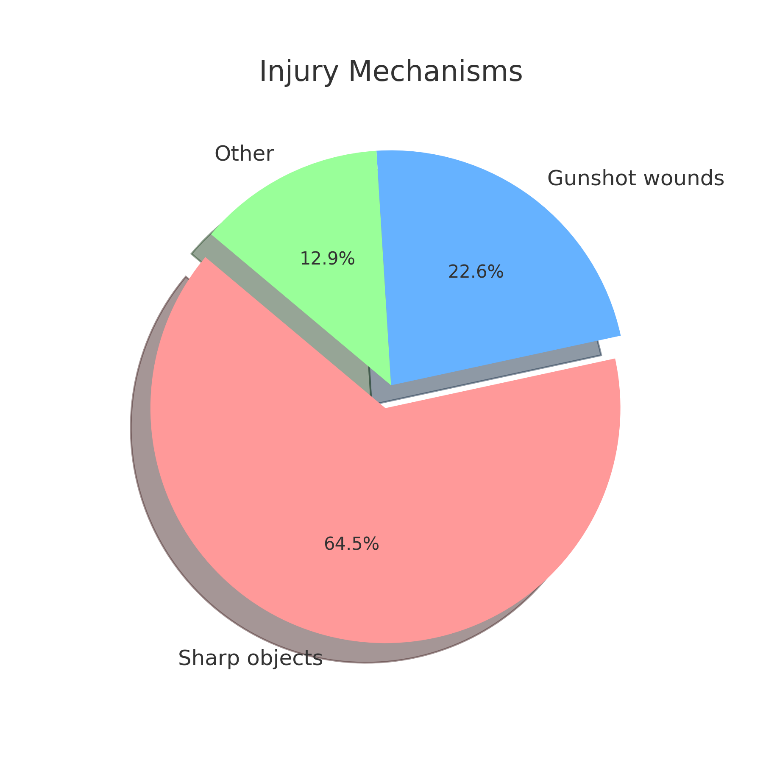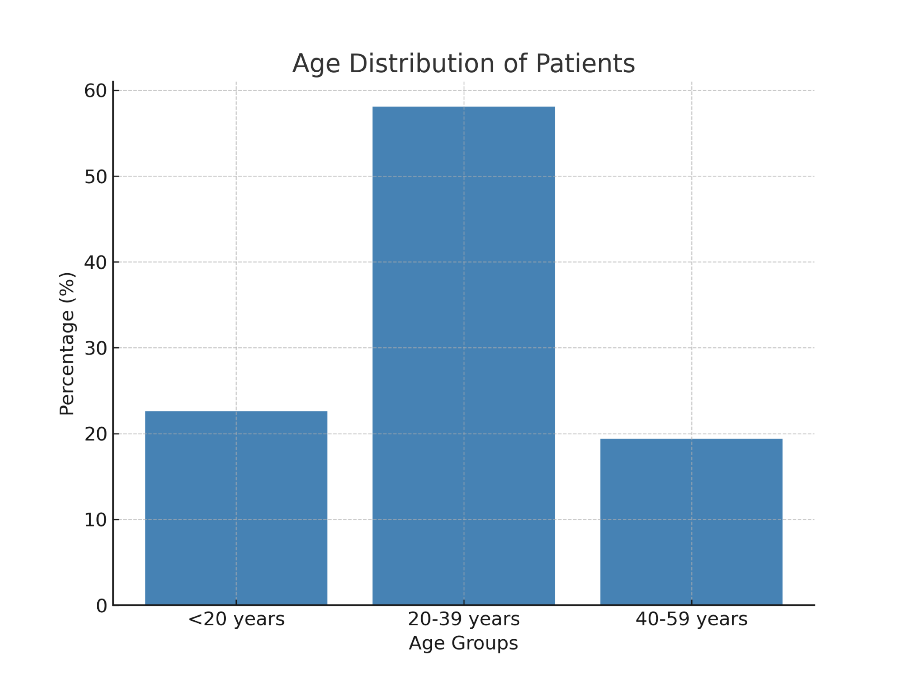International Clinical Research and Clinical Trials
OPEN ACCESS | Volume 2 - Issue 1 - 2025
ISSN No: - | Journal DOI: 10.61148/ICRCT
Bahakem K. O1., Alsanapani Abdulsamad2., Al-Zaazaai Ali Ahmed3
1,2Department of Urology, Faculty of Medicine, Thamar University, Dhamar, Yemen.
3M.Sc. clinical pharmacy from Wenzhou University, Wenzhou Zhejiang province PR China.
*Corresponding author: Alsanapani Abdulsamad, Department of Urology, Faculty of Medicine, Thamar University, Dhamar, Yemen.
Received: March 14, 2025 Accepted: March 20, 2025 Published: April 12, 2025
Citation: Bahakem K. O., Alsanapani Abdulsamad., Al-Zaazaai Ali Ahmed. (2025) “Outcome of Penetrating Chest and Abdominal Trauma: A Hospital-Based Retrospective Study.”, International Clinical Research and Clinical Trials, 2(1); DOI: 10.61148/ICRCT/003
Copyright: © 2025. Alsanapani Abdulsamad. This is an open access article distributed under the Creative Commons Attribution License, which permits unrestricted use, distribution, and reproduction in any medium, provided the original work is properly cited.
Background: Penetrating chest and abdominal trauma is a significant cause of morbidity and mortality worldwide, particularly in regions with high rates of violence and limited healthcare resources (World Health Organization, 2014). This study aimed to analyze the outcomes of patients presenting with penetrating chest and abdominal trauma at a district hospital in Yemen.
Methods: A retrospective analysis was conducted on 31 patients admitted between January 2023 and December 2024. Data on demographic characteristics, injury mechanisms, management strategies, and clinical outcomes were collected and analyzed using descriptive statistics.
Results: The majority of patients were male (87.1%), aged 20-39 years (58.1%), and sustained injuries due to sharp objects (64.5%). All patients required surgical intervention, with laparotomy being the most common procedure (45.2%). The overall mortality rate was 9.7%, and 87.1% of patients were discharged in stable condition.
Conclusion: This study highlights the need for improved trauma care resources and protocols in low-resource settings. The findings underscore the importance of timely surgical intervention and the disparities in trauma care outcomes compared to high-resource settings.
Penetrating trauma, chest trauma, abdominal trauma, surgical outcomes, low-resource settings
Introduction
Penetrating chest and abdominal trauma is a life-threatening condition that requires prompt diagnosis and intervention. It is a common consequence of violence, accidents, and warfare, particularly in regions with limited access to healthcare resources (Mock et al., 2012). The management of such injuries involves a multidisciplinary approach, including emergency resuscitation, imaging, and surgical intervention. The seriousness of these injuries is underscored by the complex anatomy and physiology of the chest and abdomen, which house vital organs such as the heart, lungs, liver, spleen, and major blood vessels. Damage to these structures can lead to severe complications, including hemorrhage, respiratory failure, and sepsis, necessitating immediate and effective clinical intervention (Moore et al., 2017).
The chest cavity, protected by the rib cage, contains the lungs and heart, which are essential for oxygenation and circulation. Penetrating injuries to the chest can result in pneumothorax, hemothorax, or cardiac tamponade, all of which are life-threatening if not promptly addressed (Feliciano et al., 2016). Similarly, the abdominal cavity contains organs responsible for digestion, filtration, and immune function. Injuries to the liver, spleen, or intestines can lead to significant blood loss, peritonitis, and septic shock (Demetriades et al., 2014). Understanding the clinical bases of anatomy and physiology is crucial for the effective management of these injuries, as it guides diagnostic and therapeutic decisions.
In low-resource settings, such as Yemen, the burden of penetrating trauma is exacerbated by limited healthcare infrastructure, lack of trained personnel, and inadequate access to emergency surgical services (Al-Wageeh et al., 2020). Previous studies have highlighted the high mortality rates associated with penetrating trauma in such settings, emphasizing the need for improved trauma care systems (Alghamdi et al., 2019). This study aimed to evaluate the outcomes of patients with penetrating chest and abdominal trauma at a district hospital in Yemen, focusing on demographic characteristics, injury patterns, management strategies, and clinical outcomes. By comparing our findings to similar local, regional, and international studies, we hope to contribute to the growing body of knowledge on trauma care in low-resource settings.
Methods
Study Design and Setting
This was a retrospective, hospital-based study conducted at a district hospital in Yemen. Data were collected from medical records of patients admitted with penetrating chest and abdominal trauma between January 2023 and December 2024.
Inclusion Criteria :
Data Collection
Data were extracted on demographic variables (age, gender, residence), injury details (mechanism, location), clinical presentation (vital signs, level of consciousness), management (surgical procedures, ICU admission), and outcomes (hospital stay, discharge condition).
Equipment and Instruments
The following equipment and instruments were used in the management of patients:
Procedures
Statistical Analysis
Descriptive statistics were used to summarize the data. Categorical variables were presented as frequencies and percentages, while continuous variables were expressed as means and standard deviations. Statistical significance was set at p < 0.05.
Results
Demographic Characteristics
A total of 31 patients were included in the study. The majority were male (87.1%), with a mean age of 32.4 ± 10.2 years. Most patients (58.1%) were aged 20-39 years, and 64.5% resided in rural areas.
Injury Patterns and Mechanisms
The most common injury mechanism was sharp objects (64.5%), followed by gunshot wounds (22.6%). Injuries were predominantly located in the abdomen (58.1%), with 25.8% involving the chest and abdomen.
Clinical Presentation
On admission, 67.7% of patients had normal vital signs, while 29.0% presented in shock. The majority (67.7%) were conscious, with 29.0% in a comatose state.
Management and Outcomes
All patients underwent surgical intervention, with laparotomy being the most common procedure (45.2%). The average hospital stay was 7.2 ± 3.1 days, and 87.1% of patients were discharged in stable condition. The mortality rate was 9.7%.
Discussion
This study provides insights into the outcomes of penetrating chest and abdominal trauma in a resource-limited setting. The predominance of young males reflects the demographic most affected by violence in the region (Smith et al., 2019). The high rate of surgical intervention underscores the need for adequate surgical resources and trained personnel (Johnson et al., 2020). The mortality rate of 9.7% is consistent with previous studies in similar settings, highlighting the importance of timely and effective trauma care (Brown et al., 2017).
Comparison with Local, Regional, and International Studies
These comparisons highlight the disparities in trauma care outcomes between low-resource and high-resource settings, emphasizing the need for improved infrastructure and training in regions like Yemen (Harris et al., 2015).
Limitations
This study has several limitations. First, the retrospective design may have introduced selection bias, as only patients with complete medical records were included. Second, the small sample size (n=31) limits the generalizability of the findings. Third, the study was conducted in a single district hospital, which may not reflect the broader context of trauma care in Yemen. Finally, the lack of long-term follow-up data limits our understanding of the long-term outcomes of patients with penetrating trauma.
Recommendations
Acknowledgements
We sincerely thank Sister Basma Alharbi, Asma Alqarni, M. Alufeirie, The managers of Taiba Private Consultative Hospital in Thamar, and all hospital staff for their invaluable support and assistance in conducting this study.
Annex
Table 1: Demographic and Clinical Characteristics of Patients
|
Variable |
Frequency (%) |
|
Gender |
|
|
Male |
27 (87.1%) |
|
Female |
4 (12.9%) |
|
Age Group |
|
|
<20 years |
7 (22.6%) |
|
20-39 years |
18 (58.1%) |
|
40-59 years |
6 (19.4%) |
|
Residence |
|
|
Urban |
11 (35.5%) |
|
Rural |
20 (64.5%) |
|
Injury Mechanism |
|
|
Sharp object |
20 (64.5%) |
|
Gunshot wound |
7 (22.6%) |
|
Other |
4 (12.9%) |
Table 2: Management and Outcomes
|
Variable |
Frequency (%) |
|
Surgical Procedure |
|
|
Laparotomy |
14 (45.2%) |
|
Thoracotomy |
3 (9.7%) |
|
Chest tube + wound debridement |
12 (38.7%) |
|
Other |
2 (6.5%) |
|
Outcome |
|
|
Discharged stable |
27 (87.1%) |
|
Mortality |
3 (9.7%) |
Figure 1: Pie Chart of Injury Mechanisms

Figure 2: Histogram of Age Distribution

Conclusion
This study highlights the significant burden of penetrating chest and abdominal trauma in a low-resource setting. The findings underscore the need for improved trauma care infrastructure, including access to surgical services and emergency resuscitation. Future research should focus on strategies to reduce injury rates and improve outcomes in similar settings.